A popular legend that has been around since at least 1937[7] traces the origin of the 1,435 mm (4 ft 8 1⁄2 in) gauge even further back than the coalfields of northern England, pointing to the evidence of rutted roads marked by chariot wheels dating from the Roman Empire.[a][8] It is curious that the Roman pace or passus was 4.855 ft or 1435 mm; a thousand such was one Roman mile. Snopes categorised this legend as "false", but commented that "it is perhaps more fairly labelled as 'True, but for trivial and unremarkable reasons'".[9] The historical tendency to place the wheels of horse-drawn vehicles approximately 5 ft (1,524 mm) apart probably derives from the width needed to fit a carthorse in between the shafts.[9] In addition, while road-travelling vehicles are typically measured from the outermost portions of the wheel rims (and there is some evidence that the first railways were measured in this way as well),[citation needed] it became apparent that for vehicles travelling on rails it was better to have the wheel flanges located inside the rails, and thus the distance measured on the inside of the wheels (and, by extension, the inside faces of the rail heads) was the important one.






